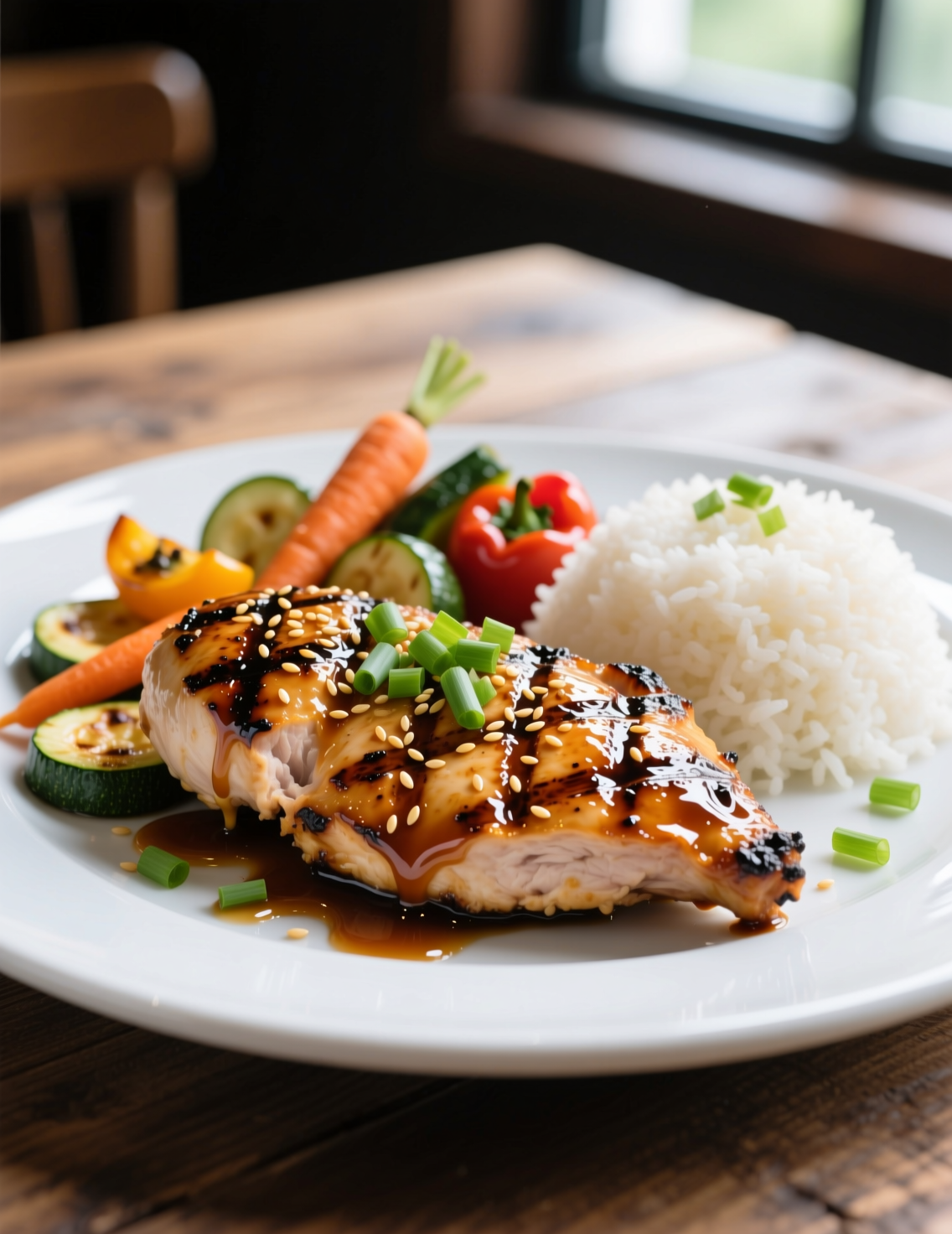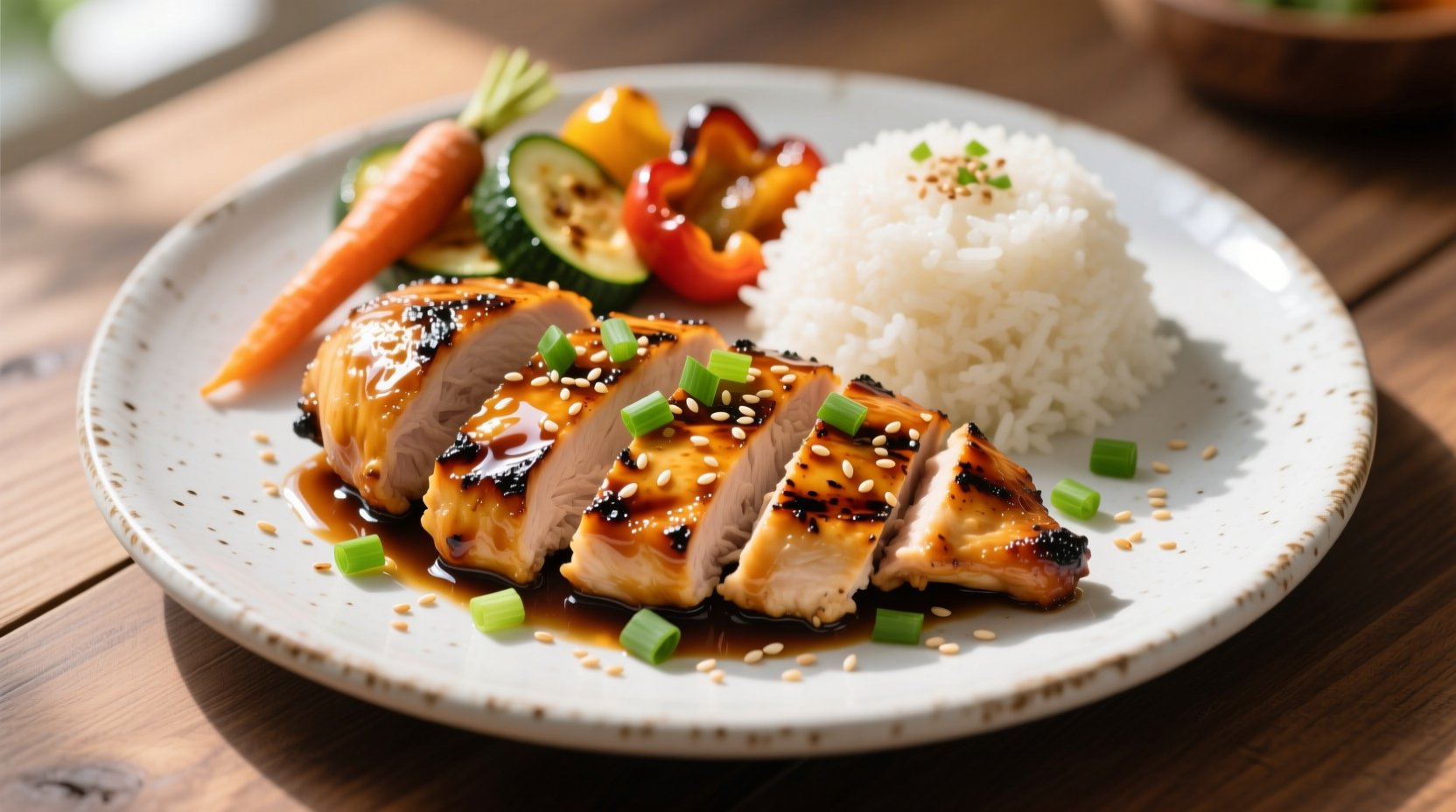Grilling chicken is simple. Grilling chicken that drips with flavor, stays juicy through every bite, and carries that sweet-savory punch of teriyaki—that’s a craft. This guide is not just about tossing chicken over flames. It’s about precision, patience, and the little adjustments that separate good cooks from great ones.
Why Teriyaki Works So Well on Chicken
Teriyaki isn’t just a sauce—it’s a technique. In Japan, “teri” means luster, and “yaki” means grilling or broiling. That glossy shine on the chicken? That’s the caramelization of sugars in the marinade clinging onto the protein surface.
Chicken is the perfect carrier for teriyaki because it absorbs flavors like a sponge. Boneless thighs, especially, hold moisture under high heat. Breasts work too, but they need more attention and a slightly shorter cooking window. Professionals know the margin of error here is razor thin.
The Ingredients That Matter
The difference between an average teriyaki chicken and a plate that makes people stop mid-bite to say “woah” comes down to ingredient quality. Soy sauce forms the backbone. Japanese soy, slightly lighter in saltiness than its Chinese cousin, gives depth without overpowering.
Fresh ginger is not optional—it wakes up the sauce. Garlic adds sharpness, while brown sugar (or mirin if you’re going authentic) gives the glaze its signature stickiness. Don’t forget sesame oil, just a touch, because too much turns the whole dish greasy.
For six servings you’ll need:
- 6 boneless chicken thighs (or breasts, if you must)
- ½ cup soy sauce
- ¼ cup mirin or dry sherry
- 3 tbsp brown sugar
- 1 tbsp fresh ginger, grated
- 2 cloves garlic, minced
- 1 tbsp sesame oil
- 2 tbsp rice vinegar
- Optional garnish: toasted sesame seeds, sliced scallions
These ratios aren’t pulled from thin air. They’ve been tested in kitchens, both restaurant and home, balancing salt, sweet, and umami to achieve harmony.
The Science of Marination
Marinating is not just soaking. It’s controlled osmosis. Salt in the soy breaks down muscle fibers slightly, allowing moisture retention. Acid from rice vinegar tenderizes, but only to a point. Too much acid, too long, and the protein tightens, leaving rubbery chicken.
Two to four hours is the sweet spot. Overnight marination works too, but with chicken breast you risk losing that natural tenderness. For thighs, overnight is fine because the fat protects them.
One trick pros use? Reserve some marinade before adding raw chicken. Later, cook it down into a sauce. This avoids the food safety issue of reusing marinade that’s touched raw poultry.
Preparing the Grill
Heat management is where amateurs stumble. High heat alone? That’s a shortcut to burned sugar and undercooked meat. You want two zones: one direct, one indirect. Start the chicken over direct heat to sear and caramelize, then slide it over to indirect heat to finish cooking gently.
Wood chunks or chips—applewood or cherry—add complexity. Even in gas grills, a smoker box makes a world of difference. The teriyaki glaze welcomes smoke; it enhances rather than competes with sweetness.
Oil the grates lightly before cooking. Otherwise, that beautiful glaze you built ends up glued to the grill instead of the chicken.
Step-by-Step Cooking
- Whisk together the marinade ingredients until sugar dissolves.
- Pour half over chicken in a resealable bag. Refrigerate 3 hours.
- Preheat grill to medium-high, set up direct and indirect zones.
- Sear chicken skin side down (or smooth side, if skinless) for 2-3 minutes per side.
- Move to indirect heat, cover grill, cook another 10-12 minutes.
- Baste with reserved cooked-down marinade during last 5 minutes.
- Rest the chicken 5 minutes before slicing.
The resting step often skipped is non-negotiable. It allows juices to redistribute instead of spilling out onto the cutting board.
Why Chicken Dries Out
The fear of undercooked chicken makes people overcook it. USDA guidelines call for 165°F internal temperature. But that doesn’t mean you must hold it there forever. Hitting 160°F, resting under foil, and letting carryover heat finish the job keeps it juicy. Professionals rely on instant-read thermometers, not guesswork.
For thighs, 170°F works better because connective tissue melts, leaving them more tender. For breasts, never go beyond 165°F, or you’ll feel like you’re chewing paper towels.
Texture and Flavor Layering
Basting during grilling builds lacquered layers of flavor. Each pass with the sauce adds shine and depth. Think of it like painting thin coats instead of dumping a bucket at once.
Adding toasted sesame seeds and scallions at the end provides crunch and freshness. This contrast is not decoration—it’s intentional textural balance. Rich, sticky meat needs brightness.
Pairing With Sides
The chicken is the star, but side dishes set the stage. Steamed jasmine rice soaks up extra sauce. Grilled vegetables—bell peppers, zucchini, mushrooms—mirror the smoky notes.
Japanese potato salad with Kewpie mayo and rice vinegar adds creamy contrast. If you want bold, try kimchi. Yes, it’s Korean, but the fermented bite against teriyaki sweetness creates harmony that surprises guests.
Common Mistakes to Avoid
People often dump all their marinade onto the chicken as it grills. The sugar burns instantly, turning black and bitter. Always thicken it separately, brush strategically.
Another mistake is flipping constantly. Chicken needs time to sear. Flipping once or twice is enough. The grill marks are not just for looks—they’re flavor branding.
Also, don’t crowd the grill. Steam builds, temperature drops, and instead of char you get pale chicken sweating in its own juices.

Nutritional and Professional Insight
A single serving of teriyaki chicken averages 280–350 calories, depending on cut and glaze. Protein hits around 25 grams. It’s lean enough for balanced diets, though sugar content can creep up. That’s why some chefs replace half the sugar with grated pear or apple puree, which adds natural sweetness without spikes.
From a business standpoint, teriyaki chicken is cost-effective. Chicken thighs are cheaper than steak or salmon but deliver robust flavors when handled properly. That’s why restaurants keep it as a staple—it’s profitable, scalable, and crowd-pleasing.
Trends in Teriyaki Dishes
Fusion cuisine has taken teriyaki beyond Japan. Food trucks serve teriyaki chicken tacos with slaw. Fine dining restaurants deconstruct it into glaze, foam, and sous-vide cuts. Even plant-based versions with seitan or tofu marinated in teriyaki are trending.
But the classic grilled version still holds power because of fire. Charcoal-grilled teriyaki chicken beats oven-baked any day. Flame imparts what no bottled sauce can replicate.
Final Tips for Professionals
Always taste the marinade before committing chicken to it. Adjust saltiness or sweetness according to soy brand and sugar level. Different soy sauces vary widely.
If cooking for a crowd, grill in batches and keep finished chicken warm in a covered pan. Never stack directly after grilling; steam softens the crust.
Plating matters too. Slice against the grain, fan out pieces, drizzle with glaze, sprinkle sesame seeds, scatter scallions. That visual appeal is as vital as the cooking itself.
Conclusion
Juicy grilled teriyaki chicken for six isn’t just a recipe. It’s a lesson in balance—heat, time, flavor, and restraint. Use high-quality ingredients, respect the science of marination, and control your grill zones.
Cook with attention, rest the meat, and build layers of flavor with care. Pair with sides that enhance, not drown, its character. Avoid shortcuts, taste constantly, and let the fire do its magic.
This dish proves something simple: technique outshines complication. Master it, and you don’t just feed six people—you win them over bite by bite.
FAQs
How long should I marinate teriyaki chicken?
Between 2 to 4 hours works best, but thighs can handle overnight.
Can I use chicken breast instead of thighs?
Yes, but breasts dry faster, so watch temperature closely.
What grill temperature is ideal for teriyaki chicken?
Medium-high heat with direct and indirect zones is perfect.
Should I reuse the marinade from raw chicken?
No, always reserve some before marinating or boil it first.
What internal temperature should chicken reach?
165°F for breasts, around 170°F for thighs for tenderness.
How do I stop the teriyaki glaze from burning?
Cook chicken on indirect heat and baste near the end.
Can I make teriyaki chicken without a grill?
Yes, use a broiler or cast-iron skillet for similar results.
What sides pair well with teriyaki chicken?
Steamed rice, grilled veggies, or Japanese potato salad work great.
Is teriyaki chicken healthy?
It’s lean and high in protein, but watch the sugar in the glaze.
Can I prepare teriyaki chicken ahead of time?
Yes, grill in batches and keep warm covered, but don’t stack.

Mariana is a passionate home cook who creates delicious, easy-to-follow recipes for busy people. From energizing breakfasts to satisfying dinners and indulgent desserts, her dishes are designed to fuel both your body and hustle.
When she’s not in the kitchen, she’s exploring new flavors and dreaming up her next recipe to share with the Foodie Hustle community.

